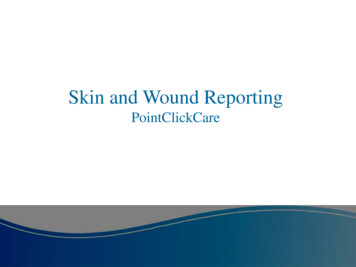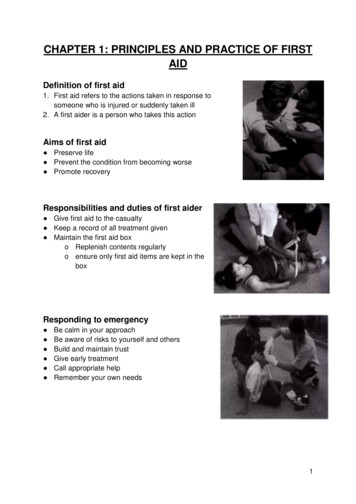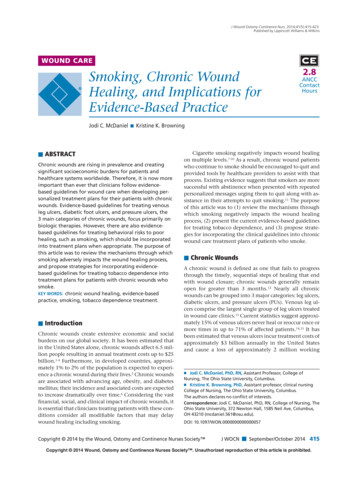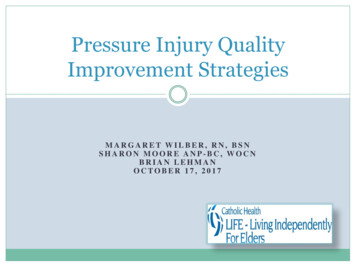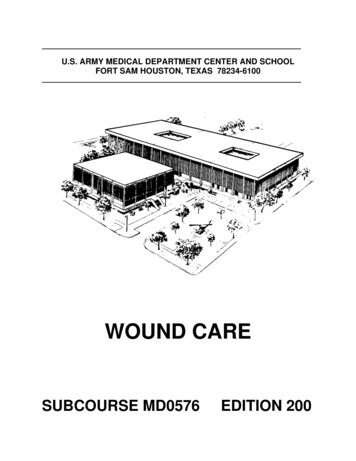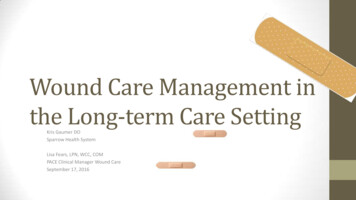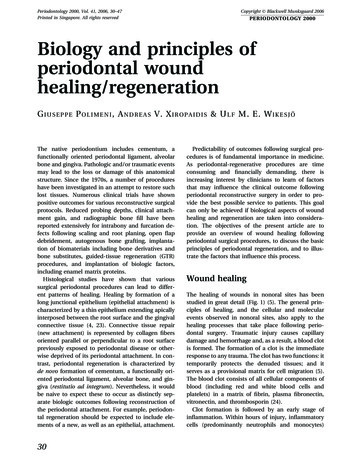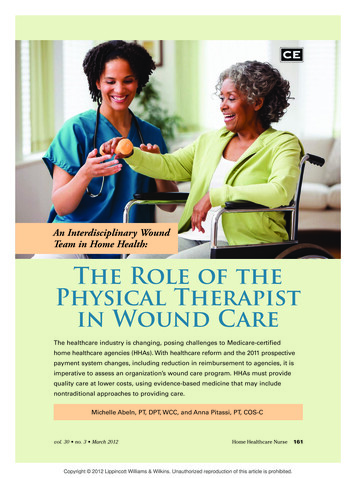
Transcription
An Interdisciplinary WoundTeam in Home Health:The Role of thePhysical Therapistin Wound CareThe healthcare industry is changing, posing challenges to Medicare-certifiedhome healthcare agencies (HHAs). With healthcare reform and the 2011 prospectivepayment system changes, including reduction in reimbursement to agencies, it isimperative to assess an organization’s wound care program. HHAs must providequality care at lower costs, using evidence-based medicine that may includenontraditional approaches to providing care.Michelle Abeln, PT, DPT, WCC, and Anna Pitassi, PT, COS-Cvol. 30 no. 3 March 2012Home Healthcare NurseCopyright 2012 Lippincott Williams & Wilkins. Unauthorized reproduction of this article is prohibited.161
ith the increase in patients beingtreated in the home for acute andchronic wounds and the rising costsof treating these wounds, it is important to have an efficient wound care team. Havingan interdisciplinary wound care team consisting ofnurses, therapists, and other clinicians involved inthe wound management provides a successful andcost-effective benefit reaped by the clinicians, thepayers, the home healthcare agencies (HHAs), andthe patients (Sussman & Bates-Jensen, 2007).WStatisticsWounds are costly and the prevalence of woundsbeing treated in home care is growing. Accordingto the Centers for Medicare & Medicaid Services(CMS), wound diagnoses and wound-related diagnoses account for 196,000 patients admitted tohome care and 6.2% of the home care population(CMS, Office of Information Services, 2009). Inthe United States, chronic wounds affect 5.7million patients and cost healthcare systemsan estimated 20 billion annually (Branski et al.,2009).Among the general population, pressure ulcersare estimated to occur among 7%-17% of hospitalized and long-term-care patients. This is estimated to cost a yearly average of 1.35 billion inthe United States. Venous ulcers affect 2.5 millionindividuals per year at an annual treatment costof 4 billion in the United States. Diabetes-relatedulcers are estimated to cost our country 5 billion,with each ulcer estimated to cost between 16, 000and 28,000 (Walker, 2008).The Unique Role of thePhysical TherapistThe shortage of nurses in the United States hasbeen viewed as the worst shortage in several decades and is not expected to improve. Accordingto the July/August 2009 Health Affairs, Dr. PeterBuerhaus and coauthors found that the U.S. nursing shortage is projected to grow to 260,000 registered nurses by 2025 (American Association ofColleges of Nursing, 2010). The physical therapist(PT) can play an integral part on the wound careteam by bringing their unique skills to the patientwith a wound, helping to ease the burden of thenursing shortage. According to the American Physical Therapy Association (APTA) Guide to PhysicalTherapist Practice, the PT provides “applicationof therapeutic procedures and modalities that are162Home Healthcare Nurseintended to enhance wound perfusion, managescar, promote an optimal wound environment,remove excess exudate from a wound complex,and eliminate nonviable tissue from a wound bed.Procedures and modalities may include: debridement; dressings; orthotic, protective, and supportive devices; physical agents and mechanical andelectrotherapeutic modalities; and topical agents”(Bohmert et al., 2003, p. 116). In home care, as longas the PT is providing a skilled therapy in thehome, wound assessment and treatment can bepart of the therapy plan of care. The PT’s role inwound care includes teaching patients to offloadheel pressure ulcers and foot ulcers related todiabetes, during mobility training. Instructing andtraining on positioning and ordering pressure reliefcushions and mattresses is also within the expertise and scope of the therapist. The home exerciseprograms taught by the PT may assist the patientwith improving circulation, controlling edema,increasing strength, and improving mobility andbalance, all of which are vital to wound healing.In many states, PTs are allowed to pursuesharps debridement in the home (Federation ofState Boards of Physical Therapy, 2011). TheAPTA’s position statement on PTs and sharpsdebridement is: “Such procedural interventionswithin the scope of physical therapist practicethat are performed exclusively by the physicaltherapist include, but are not limited to, spinaland peripheral joint mobilization/manipulation,which are components of manual therapy, andsharp selective debridement, which is a component of wound management” (APTA, 2010). It isimportant that clinicians practicing in eachstate check their state practice act before pursuing sharps debridement, as not all states permitPTs to sharps debride. If the practice act doesnot specifically mention sharps debridement,which is the case many states, it would beprudent to check with the State Board of Physical Therapy. Although the APTA does not support PTAs performing sharps debridement, thereare some states, such as Alabama, Arizona,Kentucky, and North Carolina, that permit PTAsto sharps debride if they have been properlytrained and deemed competent in wound debridement (Federation of State Boards of Physical Therapy, 2011). In cases in which the PTconducts sharps debridement in the home, noadditional skilled therapy is needed to billMedicare for the visit. This is also the case forwww.homehealthcarenurseonline.comCopyright 2012 Lippincott Williams & Wilkins. Unauthorized reproduction of this article is prohibited.
To start a successful wound care program, it is important to assessstaffing numbers in the agency and the skills of the interdisciplinaryteam. However, begin by looking closely at your patients and at youragency’s wound care needs. Identify the types and numbers ofpressure, diabetes, surgical, stasis, and trauma wounds the agencytends to have on the patient caseload.PTs providing modalities for wound healing inthe home.Research supports the use of both ultrasoundand electrical stimulation in the healing of somewounds. Electrical stimulation for wound healingis defined as the delivery of electrical current totransfer energy to a wound (Sussman & BatesJensen, 2007). Electrical stimulation assistswound healing by assisting with debriding necrotic tissue, increasing blood flow, decreasingedema, decreasing bacteria in the wound, and improving scar formation (Sussman & Bates-Jensen,2007). It can be used in all phases of wound healing and has been shown to assist with woundhealing of pressure ulcers, diabetic ulcers, venousulcers, and arterial ulcers (Kloth, 2001).Ultrasound is the use of mechanical vibrationat a frequency above the limit of human hearing.This modality has been proven to assist withwound healing through the stimulation of growthfactor and fibroblast migration, accelerate woundcontraction, and improve nutrient and oxygendelivery. Ultrasound can be delivered at a thermalor nonthermal level, directly to the wound bedor to the periwound to assist in wound healing(Poltawski & Watson, 2007).Wound Care CertificationPTs are eligible for wound care certifications. TheAmerican Academy of Wound Management certifies nurses, doctors, podiatrists, and PTs ascertified wound specialists (CWS; American Academy of Wound Management, 2011). In addition,the Wound Care Education Institute certifiesnurses, PTs, physical therapy assistants, nursepractitioners, occupational therapists (OTs), phy-vol. 30 no. 3 March 2012sicians, and physician assistants as wound carecertified (WCC) (Wound Care Education Institute,2011). The certification for the certified wound,ostomy, continence nurse (CWOCN) is open to aregistered nurse with a baccalaureate degree(Wound, Ostomy, Continence Nursing Certification Board, 2011). Each of these individual certifications requires different eligibilities, length oftraining, and cost. When developing a woundmanagement program, it is important to assessyour agency’s need to have a clinician certified inwound care. The certifications may be expensiveand time-consuming, but it may save HHAs timeand money with improved outcomes.Starting an InterdisciplinaryWound Care ProgramTo start a successful wound care program, it isimportant to assess staffing numbers in theagency and the skills of the interdisciplinaryteam (IDT). However, begin by looking closely atyour patients and at your agency’s wound careneeds (Table 1). Identify the types and numbersof pressure, diabetes, surgical, stasis, and traumawounds the agency tends to have on the patientcaseload. Are most of these patients’ woundsacute or chronic? Are there patients with multiple nonhealing wounds? What is the trend ofwound care orders coming from physicians? Arethere chronic, nonhealing wounds, with orders fordaily dressing changes? Is there a high number ofacute care hospitalizations due to deteriorating orinfected wounds and/or outliers due to inappropriate wound care treatments? These variables allhave a bearing on the cost related to the care ofyour patient (Tennvall et al., 2006).Home Healthcare NurseCopyright 2012 Lippincott Williams & Wilkins. Unauthorized reproduction of this article is prohibited.163
HHAs may review policies and procedures that clearly identify theroles and expectations of each member of the team, including whowill be performing wound care. If there is a wound specialist on theteam, it is important to determine guidelines of the specific role ofthat specialist and what initiates a referral to this individual, for theirwound management. Specific policies and procedures should be inplace about who performs certain discipline-specific treatments.Table 1. Starting a Wound CareProgramAssess home health agency financial resourcesIdentify patient populationDetermine educational needs of staffEducate and provide resourcesIdentify program championsDevelop processesPilot program before staff roll-outMarketingCollect data and assess outcomesEvaluate effectiveness of programNote. This is a series of processes that need to be performed in order.HHAs may review policies and proceduresthat clearly identify the roles and expectations ofeach member of the team, including who will beperforming wound care. If there is a wound specialist on the team, it is important to determineguidelines of the specific role of that specialistand what initiates a referral to this individual, fortheir wound management. Specific policies andprocedures should be in place about who performs certain discipline-specific treatments.It is very important to know your state practice acts. For instance, if your state regulationsallow PTs to perform sharps debridement, determine if all of your PTs will perform this procedure164Home Healthcare Nurseand if your agency requires further competencyin this area.Competency AssessmentStaff should be properly educated about thefundamentals of wound care and wound management, and they should be able to demonstrateappropriate wound care treatments. This includes how to properly assess and managewounds and understand the indications and contraindications of different wound care protocols.In addition, thorough documentation of clinicalfindings, such as wound measurements and descriptions, patient nutrition, patient mobility, andmedical necessity for pressure relieving devices,is key to successful wound management.Education can be provided to staff in a varietyof ways including free online tutorials, e-learningsystems, and in-services provided by a woundcare specialist or wound supply representative.Providing a pretest and post-test or physicaldemonstration validates that the material wasunderstood by clinicians. Determine differentcompetency levels by providing clinical skillschecklists, questionnaires, and surveys, and bycompleting joint visits with staff.One of the most important concepts for a successful interdisciplinary wound care program isteamwork and effective communication. Conflictsmay be caused by misunderstandings about theabilities of other disciplines to treat wounds, theirlevel of education or experience with treatingwounds, or battles over turf (Sussman & BatesJensen, 2007). The team must continuously worktogether through frequent communication anddevelop respect for the role that each ht 2012 Lippincott Williams & Wilkins. Unauthorized reproduction of this article is prohibited.
plays on the team. Educate the staff as to whatunique advantages each discipline brings to thecare of the patient with a wound.Detection of wounds as early as possible fromany discipline is vital so that measures and a plancan be put into place immediately. Wound carepatients should be assessed at a minimum eachweek by a nurse or the PT who is educated inwound care. The nutritional status of the woundneeds to be assessed by the dietitian and/ornutritionist. Laboratory results should be monitored, such as prealbumin, hematocrit and hemoglobin levels, and other blood test results thatare indicators of delayed wound healing. The PTand OT can provide education on positioning andsupport surfaces, including mattresses and cushions for pressure reduction. PTs can provide theuse of modalities such as ultrasound and electrical stimulation for wound healing. According toVinayagasundaram et al. all disciplines with direct patient contact, including home health aidesand speech-language pathologists, must be ableto recognize wounds in the early stages so thatsuccessful healing can occur (Vinayagasundaramet al., 2009).Collaboration and Care CoordinationWith the previously discussed nursing shortage,and the current trends predicting an increaseddemand for PTs through the year 2030 (Zimbelman et al., 2010), collaboration on patients withwounds is a key to success. This collaborationcan be accomplished through team meetings,e-mails, telephone calls, electronic medical records (EMRs), and the use of digital cameras bycommunicating and documenting status orchanges to the wound site. This communicationshould occur at least weekly and more oftenas needed.If your agency has a wound specialist, be it anurse or a therapist, it is important that this individual is involved in the IDT meetings. IDTmeetings that are focused on management of thewound care patient provided for positive outcomes during a quality-improvement initiative in2002 and 2003 by the Visiting Nurse Service ofNew York Wound Care Management Learning Collaborative. This initiative was a 9-month qualityimprovement study using 13 multidisciplinaryteams from New York City, NY, and NassauCounty, NY, branch. Outcome and AssessmentInformation Set (OASIS) data were comparedvol. 30 no. 3 March 2012Quick ReferencesAmerican Academy of Wound Management:http://www.aawm.orgAmerican Physical Therapy Association:http://www.apta.orgCenters for Medicare & Medicaid Services:http://www.cms.govFederation of State Boards of Physical Therapy:https://www.fsbpt.orgHome Health Wound Care Education Institute:http://www.wcei.netWound, Ostomy, Continence Nursing Board:http://www.wocncb.orgwithin the agency for best practices associatedwith decreasing adverse events in patients withwounds (Marren & Hess, 2006).Key points to discuss at IDT’s include:1. Wound status and management;2. Underlying causes and/or contributingfactors to the wound;3. Current orders;4. Frequency of home care visits;5. Coordination of nursing and therapy visitsfor wound care;6. Plan of care: progress/lack of progress;7. Pain assessment and management;8. Nutritional status;9. Barriers to healing;10. Status of pressure relieving equipment;11. Discharge goals;12. Patient/caregiver involvement;13. Physician involvement; and14. Consultation with wound specialist.“Using digital technology to evaluate and develop wound management techniques led to increased home care wound patient healing rates anddecreased outcome related costs” (Demarest &Acoraci, 2004, p. 63). The use of digital cameras inhome care may improve wound healing throughcommunication via photographs of the wound,thereby providing efficiency with consultations.Using digital cameras may also decrease the number of home care visits and create a means of usingwound supplies in a more efficient manner. Theclinician can download the wound images into acentral computer file for a wound specialist toHome Healthcare NurseCopyright 2012 Lippincott Williams & Wilkins. Unauthorized reproduction of this article is prohibited.165
Home Health Compare is located at http://www.medicare.gov, theofficial U.S. government site for Medicare. Process measures includetimely care, care coordination, patient assessment, care planning, careplan implementation, education, and prevention. Process measurereports will determine if the HHA used best practices to ensure thebest outcomes. The vision of CMS is to provide “the right care forevery patient every time.”assess and use to develop a wound healing protocol, which can provide greater efficiency in thewound specialist’s schedule and may provide better outcomes for the patients. Photography consents must be signed by the patient before takingpictures, and all team members using the digitalcameras must be properly trained in their use toprovide for consistency in the photographs andbest picture quality.The use of EMRs provide for greater efficiencywith care coordination. All team members canview the medical record information and betterprepare themselves for wound care visits. Thisalso allows the clinicians to plan for wound supply needs before the next visit. Through the useof EMRs, the wound specialist can consult directly from the medical record, whether it is fromthe documented visit notes or from downloadedphotographs of the wound.OASIS-C and WoundsIn 2000, CMS instituted the OASIS assessment toprovide a set of data to measure patient outcomes. Many revisions were made to the OASIS inJanuary 2010 and the revised OASIS is referred toas OASIS-C. The changes were comprehensiveand made to focus on process measures and outcomes to ensure that HHAs are providing qualitycare. OASIS-C outcomes, potentially avoidableevents, and now process measures are collectedby CMS and then are publicly reported on HomeHealth Compare. Home Health Compare is located at http://www.medicare.gov, the official U.S.government site for Medicare. Process measuresinclude timely care, care coordination, patient assessment, care planning, care plan implementation, education, and prevention. Process measure166Home Healthcare Nursereports will determine if the HHA used best practices to ensure the best outcomes. The vision ofCMS is to provide “the right care for every patientevery time” (CMS OASIS-C Guidance, 2009).Many changes also occurred with the OASIS-Citems related to wounds. Those items were revisedto reflect current national standards and more information is being collected to assist in improvingcare planning with wounds. The process measureswith pressure ulcers will help determine if a HHAis pursuing good patient outcomes and qualitycare. By adopting a team approach, your HHA maydecrease the risk for potentially avoidable eventsassociated with wounds.Quality ImprovementHHAs may want to consider having a qualityimprovement team to monitor processes and outcomes through chart audits and review of HomeHealth Compare, which are publicly reported outcomes from CMS and accessed at http://www.medicare.gov/HomeHealthCompare. The OASIS outcomemeasure that is publicly reported related to woundsis “improvement in the status of surgical wounds”(OASIS-C question-M1342). The process measuresthat are reported include “pressure ulcer prevention in plan of care” (M2250f), “pressure ulcer preventions implemented in short-term episodes”(M2400e), and “pressure ulcer risk assessmentconducted” (M1300). The potentially avoidableevent that is reported is “increase in the number ofpressure ulcers” (M1308). Collecting data will helpto determine and justify an organization’s woundcare needs to best care for their patients.When making the case for a wound care program, physicians and other referral sources inyour area may require introduction and educa-www.homehealthcarenurseonline.comCopyright 2012 Lippincott Williams & Wilkins. Unauthorized reproduction of this article is prohibited.
tion on the interdisciplinary approach to care foryour wound care patients. Having nurses andtherapists working together on the wound careteam, while demonstrating positive and quantifiable patient outcomes, can be a good marketingtool for your agency. Show your referral sourceshow the exchange of ideas from different disciplines can improve the outcomes of patients andhow each discipline provides a unique skill set(Sussman & Bates-Jensen, 2007).Case Scenario #1: Mrs. SmithThe purpose of the following case scenario is toshow the financial and functional benefits of amultidisciplinary approach to a patient with apressure ulcer. Mrs. Smith is a 76-year-old female,discharged from a skilled nursing facility to herdaughter’s home. She was referred to homehealth services for skilled nursing for woundcare for an unstageable pressure ulcer on her leftmedial buttock. Medical history includes insulindependent diabetes mellitus, hypertension, atrialfibrillation, obesity, hypercholesterolemia, anddementia. At the initial home care visit, the admitting nurse measures the left buttock woundas: 2.2 cm 5.4 cm 0.4 cm. The wound is considered unstageable due to the bed being coveredwith 85% loose yellow slough and 15% granulation tissue. The nurse notes there is a foul-smellingodor from the wound and a moderate amount ofpurulent drainage. The new wound care orderupon discharge from the skilled nursing facility isfor a silver hydrofiber dressing to be used and tobe changed twice a week and as needed for soiling. Upon start of care, the admitting nurse recognizes the need for a PT order for evaluationand treatment of the patient’s function. In addition, the nurse obtains a doctor’s order for thePT to sharps debride the patient’s wound.The PT’s evaluation finds the patient at homeand in a standard hospital bed with a regular mattress. The patient is bedbound secondary to thepatient’s daughter not knowing how to transfer her,is dependent for all bed mobility, and is dependentfor all activities of daily living. The PT plan of careis for skilled therapy two times a week and to include (1) assessment and treatment of the patient’spressure ulcer, including debridement of the woundbed; (2) patient and caregiver education on positioning, bed mobility, off-loading of the pressureulcer, and transfer training; (3) ordering of equipment to include a Hoyer lift, pressure relief mat-vol. 30 no. 3 March 2012tress, and wheelchair with pressure relievingcushion; (4) caregiver teaching on wound care; and(5) therapeutic exercise to increase strength andcirculation. By referring the PT on the case, to workon the patient’s physical mobility, ordering ofequipment, patient/caregiver education, and toassist with wound care, the nurse decreases hervisits from twice a week to once every other weekand as needed for wound assessment, medicationmanagement, laboratory work, and patient/caregiver education. Although the PT makes the majority of home care visits, the nurse in this caseremains the case manager.The advantages of having the nurse and PTwork together on this case are numerous. First,the cost related to Mrs. Smith’s care may be reduced. This is accomplished by decreasing thenumber of nursing visits needed. For example,the PT completes visits two times a week for7 weeks, for a total of 14 visits. The nurse may beable to decrease her visits to one time everyother week while the PT is on the case assistingwith the wound care. The nurse increases hervisits to two times per week for 2 weeks afterMrs. Smith has maximized her skilled rehabilitation potential and PT discharges. This is a total of8 nursing visits completed in the entire 60-daycertification period, instead of 18 visits if the PTwere not on the case. Taking an average of anagency’s visit cost at 140 (this is just an example) per home care visit, the total cost-savings onthis episode of care is 1,400. Another advantageto having the PT provide wound care is that thisprovides more flexibility in the nurse’s scheduleand may allow the HHA to accept more referrals.The patient also experiences improved woundhealing with a decrease in healing time, secondary to the sharps debridement completed by thePT. The overall functional status of the patient isimproved through the exercises provided by thetherapist, which also improves the quality of lifeof the patient and the caregiver. Improvement inthe patient’s mobility also helps to decrease thepatient’s pain and other complications that areoften associated with a nonhealing wound.Case Scenario #2: Mr. JonesThe purpose of the following case scenario, aswell as Table 2, is to show the multiple benefits ofhaving a wound care specialist on the home careteam. Mr. Jones is a 66-year-old male with an openwound to his left greater trochanter secondary toHome Healthcare NurseCopyright 2012 Lippincott Williams & Wilkins. Unauthorized reproduction of this article is prohibited.167
a burn from a fluoroscope during installation of aspinal stimulator. Medical history includes several lumbar surgeries secondary to stenosis andscoliosis, chronic obstructive pulmonary disease,depression, and smoking for 40 years. The initialHHA physician order is for skilled nursing carerelated to wound assessment and treatment andfor pain management related to the wound.Table 2. Advantages of a WoundSpecialistExpertise and knowledge of wound healing principlesCare plan oversight and decrease visit utilizationwith most effective wound treatments based onexpertise of wound specialistOne person coordinating communication andmodifying wound treatments as needed basedon expertiseUse of modalities for wound healing if woundspecialist is a PTMentor and educator for staff to properly treatwounds, decrease healing time, and improveoutcomesIncreased acceptance of discipline-specific roleswithin wound program, with PT educating therapists and RN educating nursesCost-savings for agency with in-house educatorInvolvement in chart audits to monitor and ensuregood outcomesPossible marketing toolThe patient presents with a nonhealing traumawound on his left greater trochanter, measuring3.7 cm 1.8 cm 2.2 cm; 0.4 cm underminingfrom 12 to 4 o’clock; 6.3 cm tunnel at 9 o’clock.The wound bed reveals 80% pink granulationtissue and 20% yellow slough. There is a largeamount of serosanguinous drainage and no odorto the wound. The patient reports 7/10 pain inthe wound area with movement. The wound orders are for calcium alginate to the wound to bechanged two to three times per week and asneeded. During the first 2 weeks the patient iscared for by the HHA nurse every 1 to 2 daysbecause of drainage noted to be seeping throughthe dressing. The nurse calls the agency’s woundcare specialist, who is a PT, to consult about thepatient’s care. The patient has no skilled therapyneeds at the present time and therefore, the PTmakes a nonbillable visit with the nurse to thepatient’s home. The new recommendation is fornegative pressure wound therapy to the leftgreater trochanter to be applied and changedthree times a week by the nurse.Although the PT makes a nonbillable visit to thepatient’s home to consult on this wound, it wasadvantageous to the patient, the nurse, and thehome care agency. By recommending an improvedwound treatment, the nurse made less visits to thepatient’s home, the wound healed faster, and thepatient did not have the inconvenience of a nonhealing wound with frequent home care visits(Table 3).SummaryAn interdisciplinary approach to wound care isvital to counteract the increasing prevalenceof wounds, rising costs,Table 3. Potential Financial Factors in a Wound Program and reductions in reimbursement in home care.Cost to Agency ( ) Savings to Agency ( )Research supports a significant reduction in costNonbillable visit by physical1400with an interdisciplinarytherapistapproach (Bedell et al.,01120Estimated reduction in2003). Cost-savings maynursing visits overbe achieved with the PTcertification period (n 8)and nurse sharing the0280Estimated reduction inrole of wound care clinisupply costs to agency withcian and with the PT havuse of negative pressureing the qualifications towound therapy vs. alginate( 10/visit)offer other effective treatment options such asTotal savings1,260modalities and sharpsNote. PT physical therapist.Adapted from Vinayagasundaram et al. (2009).168Home Healthcare Nursewww.homehealthcarenurseonline.comCopyright 2012 Lippincott Williams & Wilkins. Unauthorized reproduction of this article is prohibited.
debridement. In addition, this may decreasenursing visit utilization. “There are substantialqualitative research studies demonstrating positive outcomes and the value of comprehensive,multidisciplinary wound care. The wound careliterature abounds with research describing improved quantitative outcomes resulting fromcomprehensive, multidisciplinary care” (Association for the Advancement of Wound Care [AAWC]2005, p. 2). OASIS-C provides agencies with theopportunity to involve all disciplines in processmeasures to achieve the best outcomes for ourpatients.Michelle Abeln, PT, DPT, WCC, is the Rehab Preceptor and Wound Specialist at Celtic Healthcare inCarlisle, Pennsylvania.Anna Pitassi, PT, COS-C, is Rehab Manager atCeltic Healthcare in Mars, Pennsylvania.The authors and planners have disclosed thatthey have no financial relationships related to thisarticle.Address for correspondence: Michelle Abeln, PT,DPT, WCC, 220 Wilson St., #100, Carlisle, PA 0b013e318242c6f6REFERENCESAmerican Academy of Wound Management. (2011).American Academy of Wound Management Web site.Retrieved from http://www.aawm.orgAmerican Association of Colleges of Nursin
ostomy, continence nurse (CWOCN) is open to a registered nurse with a baccalaureate degree (Wound, Ostomy, Continence Nursing Certifica-tion Board, 2011). Each of these individual certifi-cations requires different eligibilities, length of training, and cost. When developing a wound management program, it is important to assess
